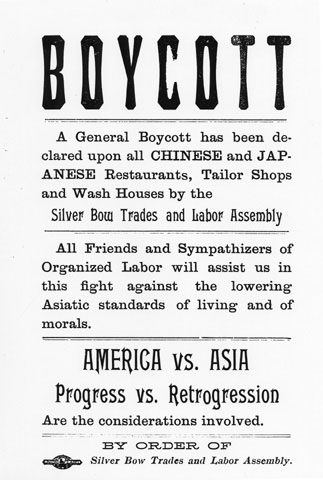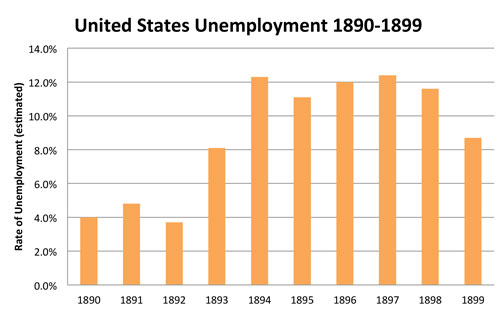ARCH
Assessment Resource Center for History
Performance Assessment Tasks
to Evaluate Historical Thinking
Performance assessment tasks are defined as the application of student understanding in the context of performing a real or authentic task. In a history classroom, there are many ways that teachers can assess understanding through student performance. These kinds of assessments will best serve teachers as formative checks on student learning as they work to develop historical understanding.
Here are two sample performance assessment tasks. The first example uses a single primary source and can be completed during a class period or less. The second example, which could also be completed in a single class period, is an extended activity, using two sources and requiring a more complex response.
Sample 1
- Topic
- The Chinese Boycott Case
- Grade Level
- High School
- Using the Item
- This performance assessment task uses one source to evaluate students’ disciplinary reading skills, as well as their knowledge of the context of events during this time period, in the process of sourcing and critically reading a document.
- Background
- This flier was issued by the Silver Bow Trades and Labor Assembly and Butte Miners’ Union, c. 1898. The union called for a general boycott against Chinese and Japanese-owned businesses in Butte, Montana. The flier, which is overtly racist, was produced at a time of anti-immigrant sentiment against Asian workers in the western United States. To assess students’ historical understanding, they need to know the context of the labor unrest during the economic depressions of the late nineteenth century, a time of growth for big business and violent labor upheavals that accompanied efforts to organize workers into unions. Asian immigrants, who comprised a small number of the workers and business owners in towns and cities in the western states, bore the brunt of restrictive immigration laws, such as the Chinese Exclusion Act in 1882, as well as the racist enmity of whites and other recent European immigrants, such as the Irish.

Source: Silver Bow Trades and Labor Assembly and Butte Miners’ Union. “Boycott.” 1898. National Archives and Records Administration, Seattle Branch, Montana, the Magazine of Western History. Accessed December 5, 2013. http://amhistory.si.edu/
perfectunion/collection/
image.asp?ID=740.
Close-Reading Strategy: Sourcing
Who was responsible for producing this document? What was their occupation? What is the publication date? Who is the intended audience?
Close-Reading Strategy: Critical Reading
What is the purpose of this document? Why do you think these groups would be promoting such action?
Contextualizing
Based on your knowledge of United States history, what was happening at this time that might have influenced public opinion about Asian immigrants?
What information is not included in the document that you might want to know?
Explanation
With documents such as this union flier, there is often more to the story that students will need to know in order to understand the context. However, teachers can assess students’ ability to develop some initial conclusions and predictions based on scant evidence, as seen here. This flier is intriguing and poses more questions than answers; therefore, it could also be used to set the context for a more detailed task with additional sources or as an introduction to a lesson around the topic.
Sample 2
Here is an expanded version of the assessment task that uses the original document together with another source.
Source A

Source: Silver Bow Trades and Labor Assembly and Butte Miners’ Union. “Boycott.” 1898. National Archives and Records Administration, Seattle Branch, Montana, the Magazine of Western History. Accessed December 5, 2013.
http://amhistory.si.edu/
perfectunion/collection/
image.asp?ID=740.
Directions: Use the sources included to respond to each set of questions. You may apply prior knowledge as you analyze these documents.
Close-Reading Strategy: Sourcing
Who was responsible for producing this document?
When was it written?
Who is the intended audience?
Why was it written?
Close-Reading Strategy: Critical Reading
What groups do the authors represent?
Why would these groups be promoting such action?
What information is not included the document that you might want to know?
Contextualizing
Based on your knowledge of United States history, what was happening at this time that might have influenced public opinion about Asian immigrants?
Now look at the chart (Source B). What is being displayed here? (Teachers may want to add scaffolding questions to assist students in interpreting the data.)
Source B

Adapted from Christina Romer (1986). "Spurious Volatility in Historical Unemployment Data," The Journal of Political Economy, 94(1): 1-37.
Corroboration
Compare the information in the chart with the flier. What relationship do you see between these two sources?
Why might the actions promoted by the flier have been influenced by the trends represented by the data in the chart?
In what ways is the information supported by what you know or have learned about this time period?
Thoughtful Application
Allow students to complete this portion at home if the class ends before they finish. Teachers can assess historical thinking skills by analyzing student responses throughout the activity and/or by assessing the thoughtful application at the end.
Directions: In the same style as the original, create a new flier that reflects the real reasons behind the conflict between workers, such as the union miners and the Asian immigrants to the American West. Be sure to provide evidence from the sources to support claims made in your flier.
Explanation
By adding a second document (the chart), students now have a clearer picture of the economic hardship facing the nation and a rationale for the sense of anger displayed in the call for a boycott. It also paints a picture of the link between economic woes and attitudes toward immigrant groups that may pose a threat to American workers. This theme takes place cyclically in American history, so teachers could also use this performance task to examine issues related to immigration in other times or in the present day.
Evaluating student learning in performance assessment tasks can be accomplished through a specialized scoring tool like the ARCH Historical Thinking Skills Rubric. The ARCH rubric was designed to assess disciplinary thinking skills along a continuum from the more accessible to the most complex. The historical thinking skills are organized into strategies (tools for analysis and interpretation) and procedural concepts (the comprehension and application of historical practices). The ARCH rubric can easily be adapted for scoring performance assessment tasks by using specific categories to assess discreet skills. As an example, a performance assessment task may focus primarily on sourcing, so teachers could simply use that portion of the rubric for that task. For more information on the rubrics for elementary and secondary instruction, see the ARCH rubric webpage.